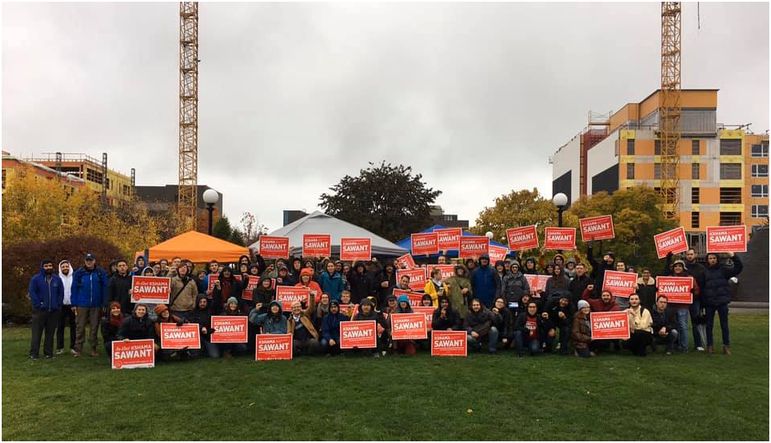Iain Dalton is a member of the Socialist Party (CWI in England & Wales).
 Review of Marx, Capital and the Madness of Economic Reason, by David Harvey
As well as 2017 marking one hundred years since the Russian revolution, it is also 150 years since Karl Marx published the first volume of Capital, a vital analysis of the underlying processes of capitalist production. In this book, David Harvey not only marks this anniversary by restating some of the key aspects of Marx’s ideas developed in the three volumes of Capital. He also discusses contemporary developments and the light Marx’s ideas shine on them.
For Harvey, the key aspect of Marx’s work was his understanding of capital as ‘value in motion’. This is the drive to invest money in order to generate a profit, and to speed up the velocity of production, circulation and the realisation of value to increase these profits. Among particularly interesting sections of the book are those where Harvey discusses the question of over-accumulation. He cites the example of 19th century Britain lending finance to build railways in Argentina, where surplus British steel and other products could then be used.
Harvey argues that China faces this issue today, having had an economy based on exports to the advanced capitalist countries of consumer goods, but also building materials such as steel and cement. The global economic crisis cut away this market and led to the Chinese regime embarking on an unprecedented stimulus package building whole new (sometimes still uninhabited) cities to absorb surplus labour and surplus production.
Harvey explains how this was possible: “It seems that the central government told everybody to take on as many infrastructure and mega-projects as possible. The banks were told to lend to developers without restraint. In the United States, when the Federal Reserve and the US Treasury gave money to the banks to lend in 2008, the banks used the money to retire their bad debts (deleveraging it is called) and even bought back their own stock [shares – to push up the value of remaining shares]. In the United States, the government does not have power over the banks. The Chinese banking system does not work that way”.
Its current infrastructure projects around the world, which Harvey discusses, particularly the One Belt, One Road, are part of the Chinese regime’s attempt to export its problems. The aim is to open up new markets and create an outlet for construction goods and labour, with state-controlled banks providing loans to the Silk Road countries this particular project is passing through. Ultimately, such a network could mean the value congealed in China’s surplus commodities can be realised instead of lying idle. In addition, those commodities already being sold can be done so faster, freeing up their value to be reutilised sooner.
Such processes build up their own new contradictions. The aim, of course, is like Britain’s railway financing in Argentina: “The improved productivity of the recipient economy redeemed the debt in time”. In a volatile world, however, what if that isn’t the case? Or, if it is, how do major powers maintain their economic dominance? Harvey discusses the USA’s participation in the Transatlantic Trade and Investment Partnership and the Trans-Pacific Partnership. He says this is as an attempt, “To create a particular value regime, one that will stop the decline in its market share of global trade at others’ expense, while counteracting weakening economic growth and profitability at home”.
Yet many of the developing economies such agreements would open up to trade are small and would end up with the US dominating and benefitting from them – like Germany’s role in the eurozone. Conversely, Harvey notes: “The abandonment of the Trans-Pacific accord by the United States has created an opening for China to step in and construct its own version of a value regime in the vacuum created by anticipated US withdrawal”.
Another related issue concerns the important role played by credit in the world economy. One of the features of the current period is the massive corporate cash hoards; the crisis has turned out to be hugely profitable for many companies. But, given the squeeze on new markets, instead of recycling those profits back into investments in new productive capacity, that money lies in company bank accounts to be lent out by the financial sector to earn interest.
However, the finance sector does not create new value. It merely leeches from value already created, paid out of the profits of the capitalists or the wages of the workers in the case of personal debt. Harvey considers this debt ‘anti-value’ in that it is effectively foreclosing on the future by demanding a portion of the value currently being produced. Personal and state debt still remains at sky-high levels, some of which are clearly unrepayable. Yet the need to redeem such large amounts of anti-value means that confidence will remain in the system until the point is reached where payments fail to be made for a significant debt or debts. The failure to redeem these values results in their general devaluation and a new crisis.
These are, of course, interesting questions, but Harvey’s book does not draw out the perspectives arising from such tendencies. He tends to leave those issues at the level of trying to explain general processes, rather than weighing up their relative impacts. One possible explanation for this is Harvey’s apparent weakness in fully appreciating the concrete struggles workers are engaged in. He identifies, in the abstract, seven ‘moments’ across Marx’s work – “technologies, the relation to nature, social relations, mode of material production, daily life, mental conceptions and institutional frameworks” – which are autonomous of each other but need parallel changes to take place across them for social change to occur.
A particularly bad example is given in relation to the Russian revolution. Harvey writes: “The failure of Soviet communism can largely be attributed to the way the interaction between all seven moments was ignored in favour of a single-bullet theory of the proper path to communism by way of revolutions in the productive forces”. This betrays a lack of serious study of the issue, not least that the key factor in the degeneration of the revolution was its isolation in one relatively backward country, while revolutionary opportunities were missed in other countries. Key to the development of socialism is a material basis to produce goods in sufficient quantities to meet people’s need. That would have been much more possible if a successful revolution had occurred in an advanced capitalist country.
Moreover, it also suggests incorrectly that the Bolsheviks only focused on economic issues. Previous issues of Socialism Today have carried articles on the huge strides the revolution made regarding women’s and LGBT liberation, in defence of the environment and other issues – before the Soviet Union’s Stalinist degeneration. It is somewhat surprising that Harvey makes this mistake. In the next paragraph he correctly comments: “What constitutes a revolution is not a political movement or a disruptive event like the storming of the Winter Palace. Revolution is an ongoing process of movements across the different moments”.
If anything, this approach betrays the lack of an understanding of real struggles. This is not the first time Harvey has made such errors. In another of his books, Rebel Cities, he mistakenly credits the SWP with having “led the successful struggle against Thatcher’s poll tax in the 1980s”!
David Harvey does draw attention to some of the contradictions within capitalism that can erupt into crisis and, with his accessible style, the reader can gain a deeper appreciation of these issues. Yet such an analysis requires a perspective of the further development of such crises and the struggles of working-class people within them. Crucially, it also requires the building of an organisation to participate in mass struggles and help bring them to a successful conclusion: the “expropriation of the expropriators” Karl Marx refers to in the first volume of Capital.
Review of Marx, Capital and the Madness of Economic Reason, by David Harvey
As well as 2017 marking one hundred years since the Russian revolution, it is also 150 years since Karl Marx published the first volume of Capital, a vital analysis of the underlying processes of capitalist production. In this book, David Harvey not only marks this anniversary by restating some of the key aspects of Marx’s ideas developed in the three volumes of Capital. He also discusses contemporary developments and the light Marx’s ideas shine on them.
For Harvey, the key aspect of Marx’s work was his understanding of capital as ‘value in motion’. This is the drive to invest money in order to generate a profit, and to speed up the velocity of production, circulation and the realisation of value to increase these profits. Among particularly interesting sections of the book are those where Harvey discusses the question of over-accumulation. He cites the example of 19th century Britain lending finance to build railways in Argentina, where surplus British steel and other products could then be used.
Harvey argues that China faces this issue today, having had an economy based on exports to the advanced capitalist countries of consumer goods, but also building materials such as steel and cement. The global economic crisis cut away this market and led to the Chinese regime embarking on an unprecedented stimulus package building whole new (sometimes still uninhabited) cities to absorb surplus labour and surplus production.
Harvey explains how this was possible: “It seems that the central government told everybody to take on as many infrastructure and mega-projects as possible. The banks were told to lend to developers without restraint. In the United States, when the Federal Reserve and the US Treasury gave money to the banks to lend in 2008, the banks used the money to retire their bad debts (deleveraging it is called) and even bought back their own stock [shares – to push up the value of remaining shares]. In the United States, the government does not have power over the banks. The Chinese banking system does not work that way”.
Its current infrastructure projects around the world, which Harvey discusses, particularly the One Belt, One Road, are part of the Chinese regime’s attempt to export its problems. The aim is to open up new markets and create an outlet for construction goods and labour, with state-controlled banks providing loans to the Silk Road countries this particular project is passing through. Ultimately, such a network could mean the value congealed in China’s surplus commodities can be realised instead of lying idle. In addition, those commodities already being sold can be done so faster, freeing up their value to be reutilised sooner.
Such processes build up their own new contradictions. The aim, of course, is like Britain’s railway financing in Argentina: “The improved productivity of the recipient economy redeemed the debt in time”. In a volatile world, however, what if that isn’t the case? Or, if it is, how do major powers maintain their economic dominance? Harvey discusses the USA’s participation in the Transatlantic Trade and Investment Partnership and the Trans-Pacific Partnership. He says this is as an attempt, “To create a particular value regime, one that will stop the decline in its market share of global trade at others’ expense, while counteracting weakening economic growth and profitability at home”.
Yet many of the developing economies such agreements would open up to trade are small and would end up with the US dominating and benefitting from them – like Germany’s role in the eurozone. Conversely, Harvey notes: “The abandonment of the Trans-Pacific accord by the United States has created an opening for China to step in and construct its own version of a value regime in the vacuum created by anticipated US withdrawal”.
Another related issue concerns the important role played by credit in the world economy. One of the features of the current period is the massive corporate cash hoards; the crisis has turned out to be hugely profitable for many companies. But, given the squeeze on new markets, instead of recycling those profits back into investments in new productive capacity, that money lies in company bank accounts to be lent out by the financial sector to earn interest.
However, the finance sector does not create new value. It merely leeches from value already created, paid out of the profits of the capitalists or the wages of the workers in the case of personal debt. Harvey considers this debt ‘anti-value’ in that it is effectively foreclosing on the future by demanding a portion of the value currently being produced. Personal and state debt still remains at sky-high levels, some of which are clearly unrepayable. Yet the need to redeem such large amounts of anti-value means that confidence will remain in the system until the point is reached where payments fail to be made for a significant debt or debts. The failure to redeem these values results in their general devaluation and a new crisis.
These are, of course, interesting questions, but Harvey’s book does not draw out the perspectives arising from such tendencies. He tends to leave those issues at the level of trying to explain general processes, rather than weighing up their relative impacts. One possible explanation for this is Harvey’s apparent weakness in fully appreciating the concrete struggles workers are engaged in. He identifies, in the abstract, seven ‘moments’ across Marx’s work – “technologies, the relation to nature, social relations, mode of material production, daily life, mental conceptions and institutional frameworks” – which are autonomous of each other but need parallel changes to take place across them for social change to occur.
A particularly bad example is given in relation to the Russian revolution. Harvey writes: “The failure of Soviet communism can largely be attributed to the way the interaction between all seven moments was ignored in favour of a single-bullet theory of the proper path to communism by way of revolutions in the productive forces”. This betrays a lack of serious study of the issue, not least that the key factor in the degeneration of the revolution was its isolation in one relatively backward country, while revolutionary opportunities were missed in other countries. Key to the development of socialism is a material basis to produce goods in sufficient quantities to meet people’s need. That would have been much more possible if a successful revolution had occurred in an advanced capitalist country.
Moreover, it also suggests incorrectly that the Bolsheviks only focused on economic issues. Previous issues of Socialism Today have carried articles on the huge strides the revolution made regarding women’s and LGBT liberation, in defence of the environment and other issues – before the Soviet Union’s Stalinist degeneration. It is somewhat surprising that Harvey makes this mistake. In the next paragraph he correctly comments: “What constitutes a revolution is not a political movement or a disruptive event like the storming of the Winter Palace. Revolution is an ongoing process of movements across the different moments”.
If anything, this approach betrays the lack of an understanding of real struggles. This is not the first time Harvey has made such errors. In another of his books, Rebel Cities, he mistakenly credits the SWP with having “led the successful struggle against Thatcher’s poll tax in the 1980s”!
David Harvey does draw attention to some of the contradictions within capitalism that can erupt into crisis and, with his accessible style, the reader can gain a deeper appreciation of these issues. Yet such an analysis requires a perspective of the further development of such crises and the struggles of working-class people within them. Crucially, it also requires the building of an organisation to participate in mass struggles and help bring them to a successful conclusion: the “expropriation of the expropriators” Karl Marx refers to in the first volume of Capital. 



